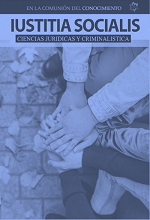Intrafamily violence during the period of confinement due to COVID-19 pandemic
DOI:
https://doi.org/10.35381/racji.v5i3.1091Keywords:
Domestic violence, social problems, civil law.Abstract
The main objective of the research is to analyze intrafamily violence during the period of confinement due to the covid-19 pandemic in the city of Riobamba - Ecuador. Descriptive methodological in nature with non-experimental bibliographic design. A total of 1695 attentions related to cases of intra-family violence were identified. It can be seen that the COVID-19 pandemic has caused several families to lose their jobs, thus preventing students from accessing education because they do not have sufficient means, because their parents do not have a job. stable and problems at home are daily being more likely to suffer from domestic violence.
Downloads
References
Chacón, C. (2020). 6.819 llamadas ha recibido el ECU-911 por violencia de género. [6,819 calls have received the ECU-911 for gender violence]. Recuperado de https://n9.cl/uvb4m
Cisneros-Trujillo, C. (2006). La violencia intrafamiliar: política criminal del Estado. [Domestic violence: criminal policy of the State]. Pontificia Universidad Javeriana. http://hdl.handle.net/10554/45092
Código Orgánico Integral Penal, COIP. Registro Oficial Suplemento 180 de 10-feb.-2014. Última modificación: 05-feb.-2018. Recuperado de https://n9.cl/xu3yj
De-Alencar-Rodrígues, R., & Cantera, L. (2013). Intervención en violencia de género en la pareja: el papel de los recursos institucionales. [Intervention in intimate partner violence: the role of institutional resources]. Athenea Digital. Revista De Pensamiento E Investigación Social, 13(3), 75-100. https://doi.org/10.5565/rev/athenead/v13n3.1058
Guerra, P., V, D., & Beltrán, D. (2020). La Desigualdad de las cargas laborales frente al COVID-19. [The Inequality of workloads against COVID-19]. CienciAméRica, 9(2), 244-250. http://dx.doi.org/10.33210/ca.v9i2.313
INEC. (2020). Los riesgos a los que se enfrentan las mujeres durante la emergencia sanitaria por el COVID-19 en Ecuador. [The risks women face during the health emergency due to COVID-19 in Ecuador]. Recuperado de https://n9.cl/v0ajl
López-Hernández, E., & Rubio-Amores, D. (2020). Reflexiones sobre la violencia intrafamiliar y violencia de género durante emergencia por COVID-19. [Reflections on domestic violence and gender violence during the COVID-19 emergency]. CienciAméRica, 9(2), 312-321. http://dx.doi.org/10.33210/ca.v9i2.319
Mayor-Walton, S, & Salazar-Pérez, C. (2019). La violencia intrafamiliar. Un problema de salud actual. [Intrafamily violence. A current health problem]. Gaceta Médica Espirituana, 21(1), 96-105.
Metro Ecuador (2020). Denuncias por violencia contra la mujer y femicidios aumentó en Ecuador. [Complaints of violence against women and femicides increased in Ecuador]. Recuperado de https://n9.cl/3j2c
Ministerio de Agricultura y Agricultura (2019). Súper Mujer Rural, un pilar fundamental del desarrollo productivo nacional. [Super Rural Woman, a fundamental pillar of national productive development]. Recuperado de https://n9.cl/f9p2
Montero-Medina, D., Bolívar-Guayacundo, M., Aguirre-Encalada, L., & Moreno-Estupiñán, A. (2020). Violencia intrafamiliar en el marco de la emergencia sanitaria por el COVID-19. [Domestic violence in the framework of the health emergency caused by COVID-19]. CienciAméRica, 9(2), 261-267. http://dx.doi.org/10.33210/ca.v9i2.316
Organización Panameriana de la salud (2002). Informe mundial sobre la violencia y la salud: resumen. [World report on violence and health: summary]. Recuperado de https://n9.cl/vhhic
Puente-Martínez, A, Ubillos-Landa, S, Echeburúa, E, & Páez-Rovira, D. (2016). Factores de riesgo asociados a la violencia sufrida por la mujer en la pareja: una revisión de meta-análisis y estudios recientes. [Risk factors associated with the violence against women in couples: a review of meta-analyzes and recent studies]. Anales de Psicología, 32(1), 295-306. https://dx.doi.org/10.6018/analesps.32.1.189161
Romero-Bello, D, & González-Blanco, M. (2017). Violencia Doméstica según la percepción de la mujer. [Domestic Violence according to the perception of women]. Revista de Obstetricia y Ginecología de Venezuela, 77(1), 30-40.
Segura-Vera, M, & Stranieri, M. (2016). Formación del personal de salud para el abordaje de la violencia de género en Venezuela. [Training of health personnel for addressing gender violence in Venezuela]. Comunidad y Salud, 14(2), 78-85.
Servicio Integrado de Seguridad ECU 911 (2020). ECU 911 superó los tres millones de llamadas recibidas durante la emergencia sanitaria. [ECU 911 exceeded three million calls received during the health emergency]. Recuperado de https://n9.cl/t9l2e
Welland, J. (2017). Violence and the contemporary soldiering body. Security Dialogue, 48(6), 524–540. https://doi.org/10.1177/0967010617733355
Published
How to Cite
Issue
Section
License
CC BY-NC-SA : Esta licencia permite a los reutilizadores distribuir, remezclar, adaptar y construir sobre el material en cualquier medio o formato solo con fines no comerciales, y solo siempre y cuando se dé la atribución al creador. Si remezcla, adapta o construye sobre el material, debe licenciar el material modificado bajo términos idénticos.
OAI-PMH URL: https://fundacionkoinonia.com.ve/ojs/index.php/Iustitia_Socialis/oai










